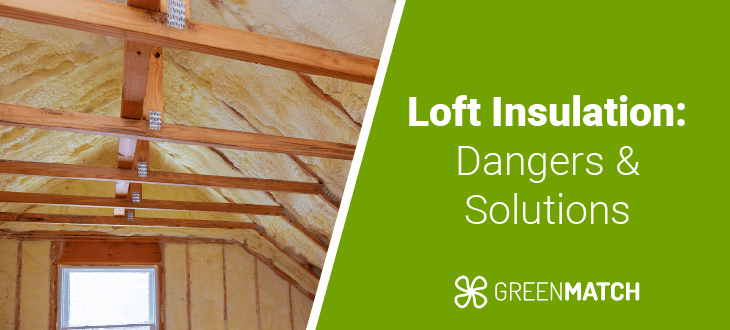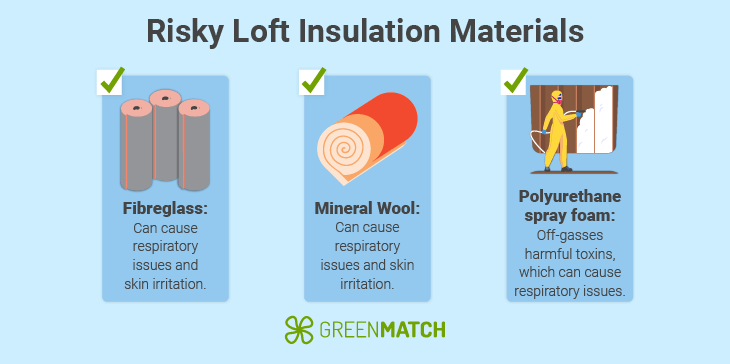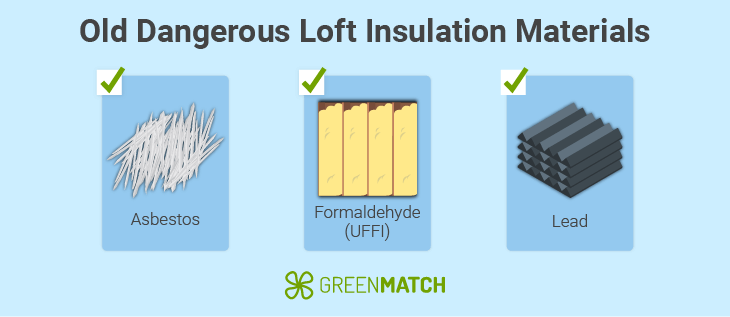Answer these simple questions and we will find you the BEST prices
Which type of solar quotes do you need?
It only takes 30 seconds
100% free with no obligation

Get Free quotes from insulation specialists near you

Save money by comparing quotes and choosing the most competitive offer

The service is 100% free and with no obligation
- GreenMatch
- Insulation
- Loft Insulation
- Is Loft Insulation Dangerous
Is Loft Insulation Dangerous? A UK Guide


- Loft insulation is not dangerous and is a splendid home upgrade. However, it’s important to work with a professional to ensure safety and long-term effectiveness.
- Uninsulated lofts and roofs are responsible for up to 26% of heat loss in a home, leading to a cold damp environment, condensation issues, and sky-high energy bills.
- Proper loft insulation can save the detached UK home up to £380 a year, as well as cut domestic CO2 emissions by up to 1 ton a year.
Loft insulation is one of the most budget-friendly and cost-effective home insulation upgrades one could install to improve one's thermal efficiency. By reducing heat loss by more than a quarter, loft insulation brings significant energy bill savings, slashes one's carbon footprint, and improves one's home's living environment.
However, is loft insulation dangerous? It’s important to note that poor workmanship or a shabby DIY job can quickly become a financial nightmare rather than a home improvement. Certain insulation materials can also pose health risks. That’s why it’s important to be wary of the dangers posed by poor loft insulation and how to avoid them.
This ultimate guide by GreenMatch UK will walk you through all you need to know about loft insulation dangers, including how to solve them and avoid them altogether.
Ready to insulate your loft? Look no further than GreenMatch UK for a one-stop solution. Simply spend 30 seconds filling out our online form, and receive up to 3 free home-tailored quotes directly from our nationwide network of pre-vetted installers. No charges or obligations. Click below to begin!
- Describe your needs
- Get free quotes
- Choose the best offer
It only takes 30 seconds



Is loft insulation dangerous?
Loft insulation is not dangerous, at least when working with newer materials and with a professional installation. The majority of the dangers posed by loft insulation hinge on the installation process itself, which is why it’s important to work with an accredited company.
In addition, certain dangers can be posed depending on the insulation materials you choose to work with. Insulation materials such as mineral wool and fibreglass, for example, are made of tiny fibres that can cause skin, eye and respiratory irritation if mishandled. Other materials such as polyurethane spray foam insulation risk off-gassing of harmful organic volatile compounds (VOCs) which are toxic to inhale and harmful to the environment.
For this reason, certain materials require proper handling by a professional with industry safety gear. While loft insulation could be handled as a DIY project, it’s highly recommended to leave the job to experts to ensure maximum safety and quality of work.
Possible dangers of loft insulation

Certain loft insulation materials require handling with safety and care, as their material composition could pose certain health risks. Here’s a breakdown of the main insulation materials to look out for when insulating your loft:
- Fibreglass: Made from recycled glass products, fibreglass is spun into blanket-like sheets that seem soft to the touch but can cause serious skin and eye irritation if in direct contact. Airborne fibreglass particles can cause respiratory discomfort, and even trigger asthma. For this reason, proper eyewear, face mask, jumpsuit and other protective gear are very important to avoid fibreglass insulation dangers.
- Mineral wool: Made from recycled rock and glass products, mineral wool is very similar to fibreglass in makeup. It’s essentially sheets of fine particles that can cause mild to severe skin and eye irritation, as well as respiratory issues if inhaled. Protective gear is very important when handling mineral wool.
- Polyurethane spray foam: Made from a synthetic expanding polymer, polyurethane poses a risk of off-gassing harmful toxins during and after installation. These fumes are not only bad for the planet but can lead to respiratory issues and even severe health damage if inhaled. An industry-standard facemask, alongside other protective gear, is highly required.
By working with a professional installer, you can ensure that all necessary safety precautions are taken with the utmost care and that you will receive a high-quality job worth your money.
Are older loft insulation materials dangerous?

Old loft insulation: Is it dangerous? Some older loft insulation materials that have been phased out of the market may still be found in some older properties. These outdated and inefficient insulation materials require removal and replacement, both for safety and thermal efficiency. Replacing loft insulation safely requires the help of a professional.
Here are some commonly found outdated insulation materials and the problems they come with:
- Asbestos: In the late 20th century, asbestos was one of the most widely used insulation materials both for commercial and residential properties. As a result, old homes built before the 1980s may still contain asbestos insulation if not renewed. As a highly toxic material, airborne fibres can cause asbestosis, lung cancer, and severe irritation if inhaled.
- Formaldehyde foam (UFFI): Very common in the mid-1900s, this expanding foam is now replaced by polyurethane and other alternatives. Formaldehyde is a highly toxic material used in taxidermy and preservation. If inhaled, the toxic fumes can cause severe respiratory issues, skin problems and even certain types of cancers.
- Lead: Due to its high resistance to corrosion, lead used to be commonly found as a component in insulation materials in older homes. This material can cause significant health concerns, especially for children, such as developmental disabilities, behavioural problems, and learning impairments.
If you live in an old property that may potentially have outdated insulation and you are unsure of its safety, consult professional loft insulation specialists to assess your property and draft out the best course of action you need. Such hazards should only be removed by an expert who is aware of how to handle and dispose of dangerous materials.
GreenMatch UK can help you by saving you endless hours of researching and vetting. By spending just 30 seconds filling out our online form, you can receive up to 3 free home-tailored quotes directly from our network of trusted professionals. The best part? Our services are completely free of charges and obligations. Click below to begin!
- Describe your needs
- Get free quotes
- Choose the best offer
It only takes 30 seconds



Is yellow loft insulation dangerous?
Yellow loft insulation is indeed dangerous. Pink or yellow loft insulation materials are older insulation sheets that used to contain asbestos as a primary ingredient. As such, yellow loft insulation and similar materials posed serious health risks during and after installation such as asbestosis, lung cancer, and irritation.
As such, yellow loft insulation is dangerous and requires removal by a professional, especially if it is room in roof insulation poses that poses a risk of direct human contact.
Then, such insulation materials can be replaced with modern-day, much healthier and sustainable alternatives such as mineral wool, sheep wool, or corkboard.
Get professional guidance on loft insulation
All in all, loft insulation is not inherently dangerous, but there are several ways that this great home upgrade could indeed pose a risk to your well-being. By working with an industry professional, you can rest assured that you receive the best service possible for an insulation upgrade that brings you comfort for decades to come.
However, many prospective customers get stuck in an endless loop of researching and vetting, with no bargain price in sight. Luckily, GreenMatch UK can alleviate this problem.
By just spending 30 seconds filling out our simple online form, we can send you up to 3 free quotes tailored to your home by nationwide professionals. In addition, our services are completely free. Click the button below to begin and land the best bargain for your home!
- Describe your needs
- Get free quotes
- Choose the best offer
It only takes 30 seconds



FAQ
Attic insulation is generally safe to be around, provided that it uses modern materials, and is secured in place correctly. In general, insulation material should not be touched as materials like mineral wool and fibreglass can cause skin, eye and respiratory irritation.
When installing loft insulation, especially those like mineral wool and fibreglass that risk releasing airborne particles, it’s highly important to use a mask. That way, you protect yourself from the risk of inhalation, which can cause mild to severe breathing problems, and even trigger asthma.
It is recommended to not touch loft insulation, especially mineral wool and fibreglass due to being made from components that will irritate your skin. If required to touch, make sure to use appropriate safety gear to limit skin contact.
To know if your loft insulation is asbestos, it is important to hire a professional to conduct an assessment. Properties built in the late 20th century that haven’t had insulation replacements since pose a great risk of containing asbestos in their insulation.
Loft insulation materials such as mineral wool, fibreglass, and cellulose release airborne particles when handled, which can cause respiratory irritation, coughing, breathing issues and even trigger asthma attacks. For this reason, it’s considered unsafe to breathe in loft insulation materials.

Akif is a copywriter at GreenMatch since 2023. With a keen interest in community sustainability, green solutions and the role of digital media in identifying climate trends, he aims to hone in on his background in International Studies and Digital Media to provide a multidisciplinary approach to written content rooted in credible research and accuracy.
We strive to connect our customers with the right product and supplier. Would you like to be part of GreenMatch?

